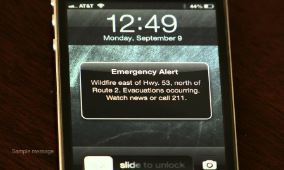Emergency managers across the country want the FCC to speed-up improvements to the Wireless Emergency Alerts system. While upgrades like improving geo-coding to better target alerts and the introduction of multimedia elements are slated to take effect in 2019, alert originators want the changes now. Comments to the FCC on the issue were due Tuesday.
The New York City Emergency Management Department says “multimedia is universal in today’s mobile-connected environment, except for emergency alerting.” NYCEM stresses that multimedia technology is not “emerging or unproven” in filed comments. NYCEM reaffirms the public would benefit from WEA-transmitted multimedia, even if such content was delivered with a slight delay following the text portion of the WEA message.
The City of Los Angeles, referring to recent fires and storms, was more blunt, saying failure to act on multimedia leaves the city “susceptible to more potential disasters without the ability to properly alert our residents….It will erode the trust of wireless alert originators to send a timely, informative message when life or death may be on the line.”
Carriers like AT&T say they’re working on the issue, but need time. “Despite technological advancements and standards work, incorporating multimedia content into WEA sent using proven cell broadcast technology still presents significant challenges, AT&T told the FCC this week. The carrier urged the Commission not to require multimedia content in WEA messages until solutions are identified and standardized.
As a stopgap measure, AT&T said the FCC should urge alert originators to use embedded references in WEA messages, like URLs, a capability available now — to deliver multimedia content. “URLs may be used to direct WEA recipients to appropriate sources of further information, such as web pages containing rich multimedia content, as well as broadcast radio and television. This approach would reduce or eliminate many concerns including backwards compatibility, interoperability/roaming, and ubiquity raised by multimedia messages,” said AT&T.
CTIA, representing carriers, device manufacturers and suppliers, agrees embedded links within WEA alerts allow originators to send multimedia emergency information today. WEA was intentionally designed to transmit only very small amounts of text data to ensure the timely delivery of WEA messages to millions of wireless consumers, it notes. The association stresses stakeholders should focus on “reasonable and practical methods for designing, implementing, and enhancing the voluntary WEA system and allowing the time for standards-based technology to be developed, tested, and implemented.”
Attempting to “segment” a large message, such as an image or video, over multiple WEA messages presents “significant challenges” over the carrier networks and on devices, according to the association. It adds that under the current technology, a device would need to wait until all the segments are received and then re-assemble the message, creating a delay. Some 25 industry standards require review and updating to implement enhanced geo-coding capabilities and the industry is also working to expand the number of characters in a WEA alert — from 90 to 260 — by May 2019.
The Federal Emergency Management Agency said it’s technically possible to require multimedia content in WEA today and many originators do so, including links to images, audio files and web file content. The National Oceanic and Atmospheric Administration’s National Weather Service agrees, telling the Commission it supports requests by multiple agencies to adopt rules so that an interactive map can be included in WEA. The threat area can be displayed on maps already built into the device such as Google Maps or Apple Maps, says NOAA NWS.
By Leslie Stimson, Inside Towers Washington Bureau Chief
Published May 31, 2018





Reader Interactions